Last Updated on May 11, 2023 by Dee
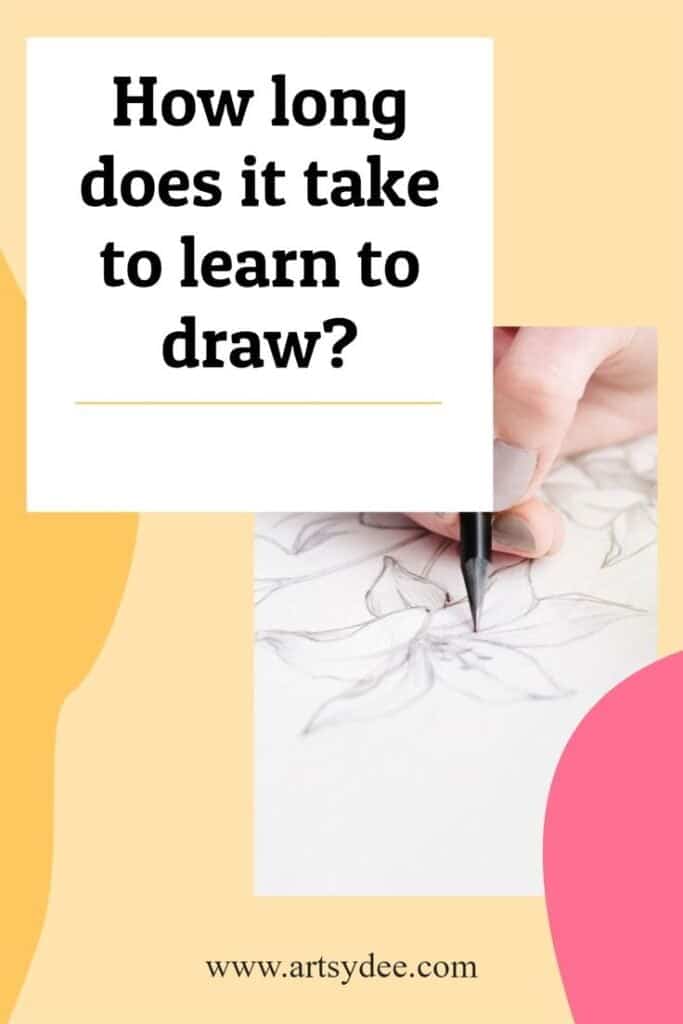
I am an artist and art teacher. I have been teaching for 15 years and drawing since I could hold a pencil.
One question that has always fascinated me is how long does it take to learn to draw?
Is there such a thing as just being “good” at it or is it something that you can always keep working on? Can anyone be good at drawing if they work hard enough?
This blog post will explore these questions in-depth by looking closely at the process of learning how to draw. I’ll also talk about some things you can do right now if you’re ready to start drawing today (or any time soon).
So you want to learn how to draw? Drawings are a great way for artists of all levels and ages to express themselves.
Drawing is also one of the best ways for people who don’t consider themselves “artists” to get comfortable with art-making.
First, find an art medium that interests you. There are so many different types of materials out there – pencils, charcoal sticks, watercolors, oil pastels – it’s easy enough just looking at them online or in-person at your local art supply store.

How long does it take to learn to draw?
How long does it take to learn to draw? This is a question that I get asked all the time and one that is difficult to answer. There are so many variables, like what kind of drawing are you looking at learning, how much instruction you have had, etc.
In this article, I will analyze the various factors involved in learning how to draw and how long you can expect it to take.
What is the average time it takes someone to learn to draw?
In general, it takes between 2-3 years to become proficient in most areas of art like drawing or painting (this is without any formal instruction.).
If someone is taking regular drawing classes with an instructor then they should expect to take at least 6 months for basic skills and another year or two for more advanced skills.
There is, of course, a large difference between learning how to draw and actually mastering drawing.
Drawing mastery takes years and years. Yes, some people are born with an innate ability to render the three-dimensional world in 2D, but even those with natural talent have to spend a lot of time practicing their skills to become masters.
Variables that influence how quickly you learn to draw.
Drawing well is a matter of developing observational skills as well as utilizing various sketching techniques and building actual drawing skills.
There are several factors that influence how quickly you learn to draw.
How much time do you practice drawing?
It’s important to practice every day, or at least several times a week if you want to see any real progress and not just get frustrated.
How many hours a day should you practice drawing?
The more practice time you have the faster you learn.
I recommend at least 20 minutes a day.
Having the right tools
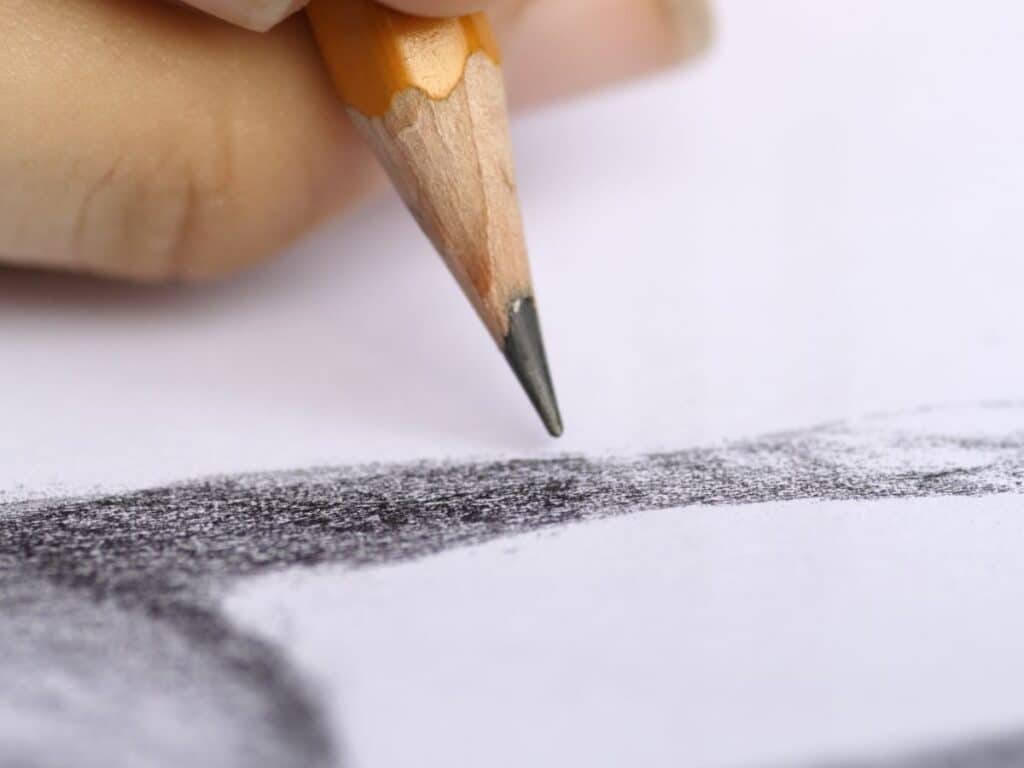
Not using the right kind of pencils, or drawing on flimsy paper can have an effect on the quality and progress of your drawing.
Using the right materials makes drawing a lot easier and helps you achieve your drawing goals.
How much instruction do you have?
If you’re taking lessons from someone, then your learning will be more efficient.
But if you’re teaching yourself then it may take a little longer to get to the same skill level as someone who is being taught.
Art teachers are amazing and can help you grow enormously in your artistic ability, but if you can’t find the right teacher, or you just can’t afford to pay for classes, you can certainly teach yourself. You should definitely explore drawing and art tutorials on Youtube!
I recommend finding a balance between learning at home and in class. This will help you define your own personal art style.
Patience
You really need a good dose of patience! You will not see much progress in the beginning.
This is just part of the process and it’s normal.
The more you practice, the better you get. It takes time for your brain to form new neural connections so that you can control your fine motor skills; i.e., how well you can control your hands, wrists, and arms when drawing.
[Related: 121 Easy Objects to Draw]
Determination
Every successful artist starts out being determined to create something.
If you’re determined to learn how to draw, it will happen!
It might not be a short journey, but if you want to do it then YOU CAN DO IT. I promise!!!
Observation
The most important part of learning how to draw is learning how to see!
In other words – observation. This is such an important skill and there are so many ways that you can practice observation.
Go have a look around your neighborhood or in the city to find objects, places, people for figure drawing, animals, even draw anime characters from your favorite movie or graphic novel… whatever you want. Spend time carefully observing them and then draw them.
If your subject is moving, then actually try to work while they are moving or a few moments after they have moved.
Attitude
Learning how to draw takes time, and you need to be patient and persistent but mostly – you also need a positive attitude.
If you get frustrated easily – then you need to set yourself small achievable goals that you can easily attain. This will build your motivation and keep you enjoying learning how to draw!
Tips to help you improve your drawing fast!
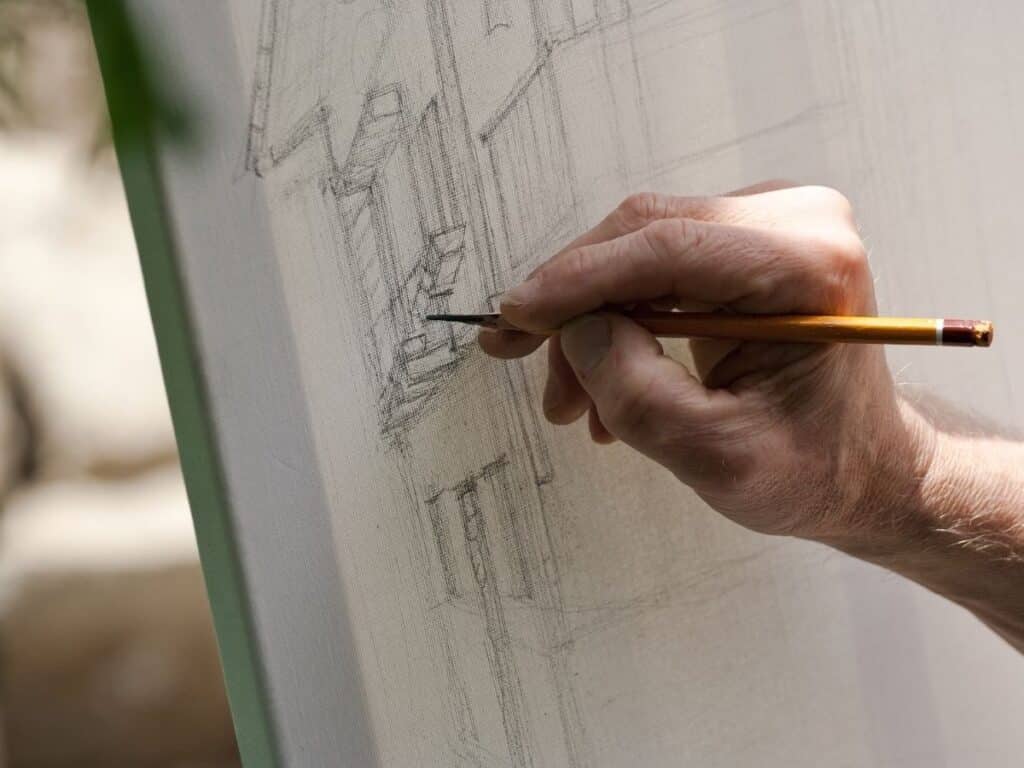
The following tips will help you speed up your learning to draw process, but it’s really important that you bear in mind that there are sadly no shortcuts, and learning to draw does take time!.
But is it worth it? Yes, it absolutely is! When you look back at your drawing and how you have grown you will feel so proud that you took the time and made a commitment to achieving your goals.
Always Plot Out Your Composition First
You should always have a clear idea of what you are going to be drawing, and what the composition of your drawing is before you start.
If you want to achieve more accuracy and realism you should lightly plot out the shapes and objects of your subject matter first. Softly sketch your outlines using a 2B or a 4B.
Get a basic idea of human anatomy (and animal anatomy)
Knowing how the human body fits together (and how the muscles, vascular system, and skeleton works) will help you make more realistic drawings.
If you are aware of what is happening beneath the skin of a human body, you will have a better idea about how it moves in space, and how to draw it in various positions.
The same goes for animals. If you want to learn how to draw animals, then study them!
Animals are actually a great subject to start with because they have many unique forms and characteristics which will help you improve your observational skills and drawing skills at the same time.
When drawing both human and animal forms, notice where the joints are and how they bend. Sketching these joints accurately will give you a more realistic drawing.
Break your subject matter down into its simplest shapes

Before you start drawing, identify the shapes that make up your subject matter.
If you look at a car, for instance, what are the shapes that make up a car?
Well… the basic structure is just a rectangle. The wheels are circles (or ovals) and if you look inside – there might be a few circles too. That’s it!
Drawing a car is not as hard as you think if you study the forms and simplify them. If you get stuck or are having trouble simplifying things then maybe looking at how other people draw might help. Sometimes, when we see how someone else has broken things down we can see things differently.
Practice Drawing Movement
Drawing a moving subject is an excellent way to challenge yourself to draw what you see.
If you’re drawing a person or animal who is moving, then practice getting their pose right before you start sketching the movement of the body.
[How to Get Ideas for Drawing: 31 Ways to Find Unique Ideas]
Stand back!
When you are drawing, it is important that you step back away from your work and view it from a wider angle.
This gives you a better idea of where things are working well, and where you may be going off course.
It’s also really important to give yourself regular breaks and rest your eyes. This helps you to view your drawing with a fresh perspective and prevents you from rushing things because you are tired.
Join a drawing class
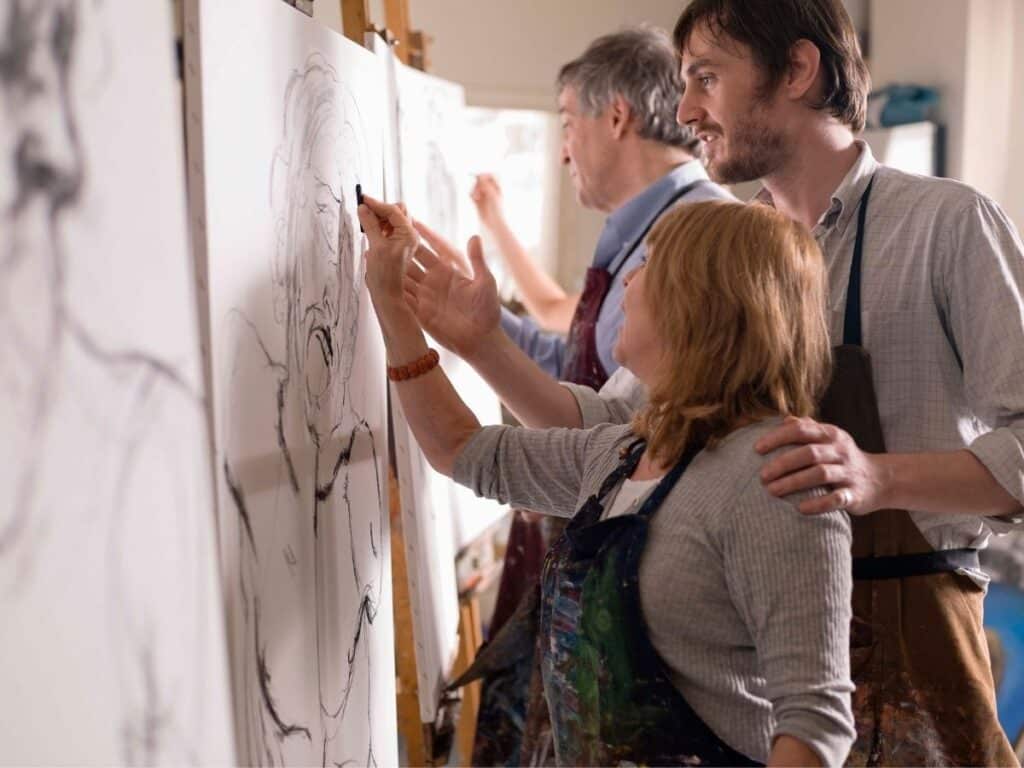
Joining an art class is a great way to improve your drawing. You will have the challenge of having to attend classes, and learn alongside other people in a group setting. Making this commitment to improving your drawing will be so worthwhile in the long run.
Art classes also give you a chance to meet like-minded creative people and make friends.
There’s also something about discussing with others that help you to see things differently sometimes – you might come away from the class with more ideas, or maybe someone might point out a problem in your drawing that you might have overlooked.
Don’t be afraid to make mistakes
You can always correct a mistake or erase it completely, but it is important that you allow yourself to make the mistake first. These are important building blocks in the development of your drawing skills.
If you are scared of making a mistake, then that hinders your progress in drawing. Soon enough you will learn from your mistakes and avoid them in the future.
Practice, practice, practice!
Drawing is something you have to practice regularly. The more you draw, the better you’ll get.
[Related Article: Improve Your Drawing]
How long does it take to become a skilled artist?
It depends on how much you practice. I know of people who have become very skilled in just a few years, and there are also others who become skilled only after 10 or more years of regular drawing.
So… if you want to draw well then make it a priority in your schedule. Practice regularly – even if it’s just a few minutes each day. I guarantee that you will begin to see improvements in your drawing if you stick with it!
What kind of progress should you expect? Well… there’s no set path for learning how to draw and progress is determined by many factors – including how much time you can commit, where you are starting from, and how often you practice.

10,000 hours?
Malcolm Gladwell invented the idea if one wants to master a new skill he can use 10,000 hours. In his book Outliers, he claims that the key to becoming an expert at something is, to a large extent, a matter of practicing the action for 10,000 hours.
The idea was further popularized by Dan Coyle in his 2014 book The Talent Code: Greatness Isn’t Born. It’s Grown.
Coyle breaks down 10,000 hours into about ten years of regular practice.
Gladwell himself linked expertise to a lifetime of deliberate practice. He said: “It is not enough to have the potential for greatness; one must also have the mindset and surrounding environment conducive to reaching that potential.”
Leonardo da Vinci drew for 6-8 hours a day, nearly every day of his life.
[Related article: How to create the illusion of depth in Art.]
Progress is relative
“Drawing well” is something hard to quantify. Don’t compare yourself to others.
Instead of assessing what other people are doing assess the progress of one’s own advancement.
Everyone is different
Although 10,000 hours to master drawing might make sense, there are some limitations.
Why is that?
Well, because people are not uniform. Some people excel at certain things and have greater aptitude than other people.
The amount of time necessary to master a subject will vary depending upon the person’s capacity for learning.
Although the 10,000-hour rule is just an estimate and can vary from person to person, it does indicate to us that to master drawing you need to draw regularly, and over a long period of time.
[Related article: How to Improve Your Digital Creations | 22 Digital Painting Tips]
Try to Find Your Drawing Style.
I think it’s important to try and find out your drawing style. You should experiment with different tools/tutorials until you eventually figure out what works for you and what feels natural.
Don’t force yourself to draw in a particular style!
You don’t need to draw like “so-and-so” or conform to some ideal of what good art should look like.
If you force yourself to draw a particular way that’s not your style, it might come out somewhat contrived – and then you might be chasing something that doesn’t feel natural.
Instead of doing that, experiment and explore to find out what works for you! Let me restate that…
Don’t make yourself do art like somebody else. Allow yourself to gently explore different drawing techniques and enjoy the process.
[Related Article: How to Find Your Art Style]
Enjoy the journey of drawing.
A great attitude to have is that you like the process – not just the results. Enjoy drawing for its own sake. If you enjoy it, then you will keep coming back to draw more and more!
Don’t expect to be a master in one night. You need years of practice but don’t give up!
There is no one-size-fits-all approach to learning how to draw, but some general guidelines include:
1. Keep at it and practice regularly!
2. Slow down your strokes, shorten them, use less pressure, wider pencils, and slower speeds when you are first starting out.
This will allow you to build up your hand muscles. Don’t hold the pencil with a death grip!
3. Draw from life as much as possible – it will build up your eye-hand coordination skills and develop your perception skills.
Draw in everything you can get your hands on, even if it’s not considered a traditional art medium. This helps you to stretch your imagination and develops your mark-making repertoire.
The more you draw, the better your eye-hand coordination will become.
4. Observe how objects “sit” in real life – for example: observe how light and shadows fall on an object, study how different textures occur using different visual elements such as contour lines or shading.
How long does it take to learn different drawing styles?
It can take a very long time to get good at drawing if you are intending on mastering different styles. Mastering one or two styles is more realistic so that’s what I’d recommend in terms of how to learn how to draw.
Let’s assume you want to become an expert in just one particular style – let’s use realism as an example.
It can take years and years to learn how to draw using the realistic drawing style, so don’t expect to become a master immediately.
You have to be persistent, keep at it, and work at it often if you want to get better over time.
How long does it take to learn to draw realistically?
It can take a long time to learn the drawing skills and techniques needed to draw things in a realistic manner. If you are starting as a complete beginner then it takes an average of a year before you can easily draw a realistic object.
In order for drawing to be realistic, it has to have a certain amount of accuracy in the proportions of the subject, accurate light and shadow, and an understanding of how to create textures.
Many beginner artists start by drawing portraits.
Drawing still life with fruit or objects is better suited for beginners because they can easily see how shadows and light fall on different objects individually and in relation to other elements.
To achieve realism you should know how to draw correctly and,as I have mentioned, the best way to learn to draw realistically is by observing reality.
You can’t just “wing it” if you want to create realistic drawings. You must study how things exist in real life and then draw from that.
How long does it take to learn to draw comics?
If you are talking about the traditional cartoon style, then your learning curve depends on how much time you spend practicing cartoon-drawing techniques.
If you pursue this topic more seriously, then you may be able to achieve great results within a year.
How long does it take to learn how to draw an anime character?
If you are striving to learn how to draw a perfect and beautiful anime have patience! It can take you a long time to learn how to draw an anime-style character.
Many beginners prefer anime drawing because it’s very “happy” and seems easy, but when they start, it turns out that things are more complicated than they thought.
It can take years before you are good enough to make a living out of drawing Anime characters.
However, let this not deter you – because if you have enough discipline and courage to keep practicing your anime skills you can do very well in the world of digital illustration and digital art.
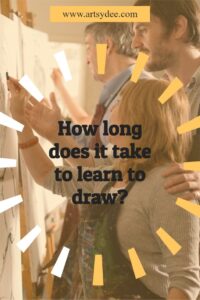
How long does it take to learn to draw a portrait?
Depending on the complexity of the portrait may take you anywhere from a few months to years to learn how to draw them.
How long does it take to learn to draw a realistic portrait and how does this differ from drawing cartoons and manga style?
Drawing anything in a realistic manner takes quite some time. Just like there is good detail involved when you draw in an anime or cartoon style, the same goes for drawing realism.
How can I get good at digital drawing?
If you want to learn digital drawing, it’s best if you start with the basics.
Like any other art form – knowing the fundamentals of drawing with pencil on paper is an important first step before moving on to the computer screen.
If you want to use the computer to draw, then it’s important that you understand how to translate your pencil drawings and sketches into digital form.
When learning how to draw on the computer, I would suggest using a drawing tablet such as Wacom, so that you can really grasp what a touchscreen is capable of.
I currently use an iPad Pro and Procreate to create digital drawings and digital paintings, and I love the capabilities of this combination.
I use a Paperlike Screen Protector on my iPad which makes gives a more natural feeling to drawing and painting. For me, this is the closest digital art comes to traditional painting and drawing! I also want to mention that
Other Frequently Asked Questions About How Long it Takes to Learn to Draw:
How many hours a day should you practice drawing?
Well, it really depends on your goals. Try to practice at least 15-30 minutes a day to see results.
Can you teach yourself to draw?
Yes, you can and in fact, many people do. Whilst you do not really need a teacher for everything, having professional advice can accelerate your learning curve.
Follow Youtube videos and read how-to books and practice, practice, practice.
Should I take art classes to learnt to draw?
You can teach yourself or you can take an art class, but it’s also perfectly fine to do both – teaching yourself and taking a few classes at your local community center.
What should a beginner start drawing?
It doesn’t really matter what you draw as long as it is something that sparks your curiosity and interest.
It’s all about drawing what you love to draw, and don’t worry if the subject isn’t too easy at first – every time you make a mark on a page you are creating or reinforcing a neural pathway that strengthens your drawing skills!
Some great drawing ideas for beginners are:
- Leaves
- Fish
- Flowers
- Eyes
- Hands
- Shoes
Is drawing hard to learn?
Some parts of the drawing will be more difficult for you than others. Remember to just let go, enjoy the process and keep going.
Embrace the challenges and keep practicing.
Can I learn drawing in 1 year?
Yes, absolutely. Learning to draw is not something that happens overnight, but with dedication and the right practice techniques, you can learn how to draw in a year.
How long should a drawing take?
A drawing can take anywhere between 5 minutes to 2 hours, or even more depending on how complex your subject is.
As you get better at drawing you will become faster at achieving correct proportion, perspective, and tone.
How long does it usually take to get good at art?
It’s different for everyone, but for most people, it takes approximately 2-4 years to get very good and really start to see excellence in your work.
Is sketching easy to learn?
Sketching is great for understanding the shape and tone of an object or a scene. If you are interested in learning how to draw cartoons then sketching is definitely one of the building blocks of how to draw cartoons and comics.
How long does it take to be a good sketcher?
It depends on how serious you are about drawing and sketching. Some people pick it up faster than others and then there are people who become very dedicated to their craft and practice every single day of their lives.

Conclusion
The process of learning how to draw can be difficult and complicated, but it is also rewarding.
If you have the patience and drive to keep working on your drawing skills through all stages of development, there’s no stopping you from being a skilled artist with time!
If you’re wondering “How long does it take to learn to draw?” this article should give you some indication of what your learning curve timeline may be.
So what are you waiting for? Get your sketchbook out and start drawing!
Other articles you may enjoy…
